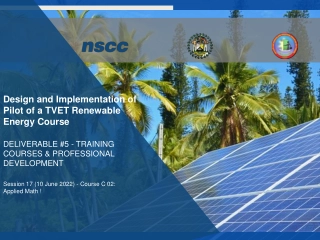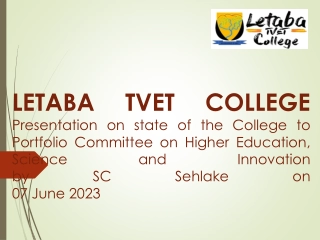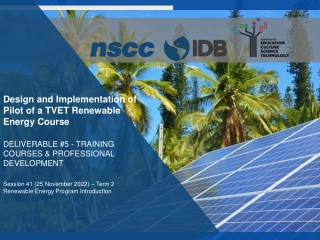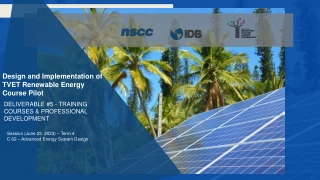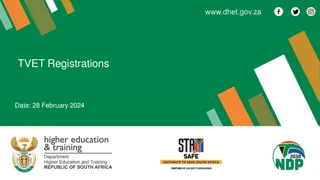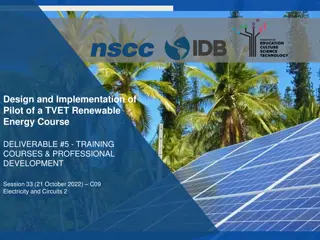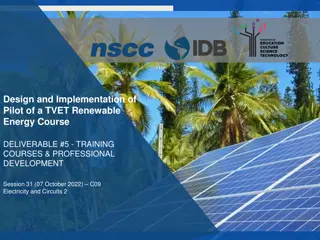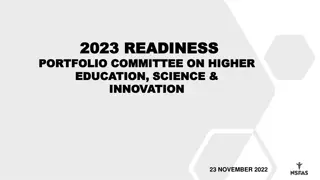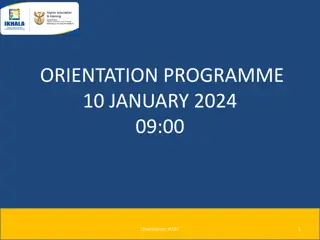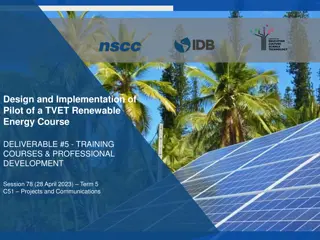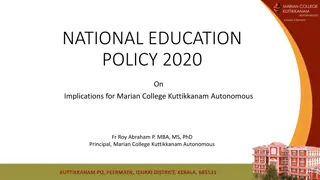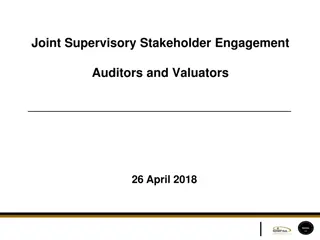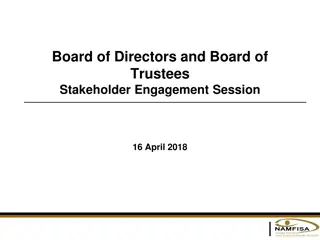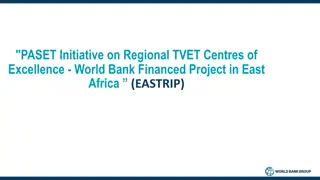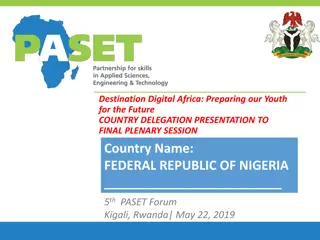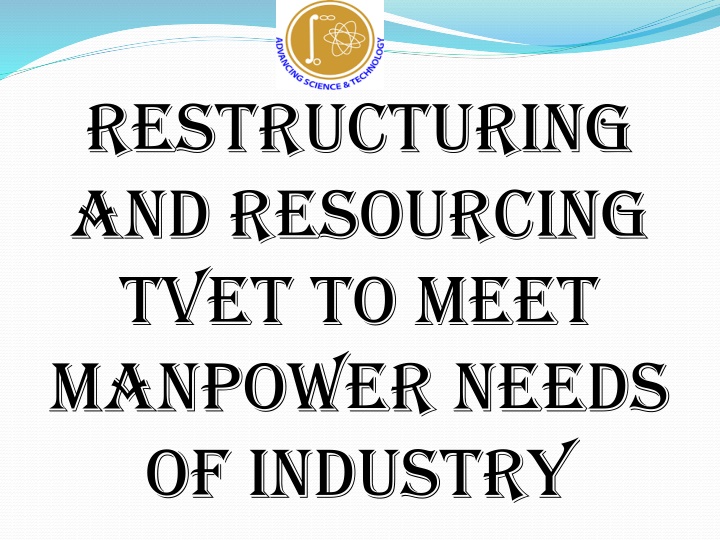
TVET Restructuring and Resourcing for Industry Manpower Needs
Explore the significance of Technical and Vocational Education and Training (TVET) in meeting industry demands. Learn about the importance of resourcing and restructuring TVET to address the skills gap and enhance workforce quality for sustainable economic development.
Download Presentation

Please find below an Image/Link to download the presentation.
The content on the website is provided AS IS for your information and personal use only. It may not be sold, licensed, or shared on other websites without obtaining consent from the author. If you encounter any issues during the download, it is possible that the publisher has removed the file from their server.
You are allowed to download the files provided on this website for personal or commercial use, subject to the condition that they are used lawfully. All files are the property of their respective owners.
The content on the website is provided AS IS for your information and personal use only. It may not be sold, licensed, or shared on other websites without obtaining consent from the author.
E N D
Presentation Transcript
Restructuring and resourcing TVET to meet manpower needs of industry
The main hope of a nation lies in the proper technical and vocational education and training of its youth and young adults Erasmus
PRESENTATION POINTS Introductory background TVET Policy of 2004 Restructuring TVET, Resourcing TVET, Quality work force to meet Industry needs.
INTRODUCTORY BACKGROUND The main objective of TVET is to prepare learners for the world of work with the curriculum emphasizing on the acquisition of employable skills TVET is to identify and develop key competences that are relevant to current and future skills to meet the needs of the labour market. In order to enhance productivity, stimulate competitiveness, and bring about sustainable economic development, TVET skills development is vital.
INTRODUCTORY BACKGROUND contd Amongst other things countries realize that TVET is a means to jumping onto the bandwagon of globalization. This is reflected by the tremendous shift of employment from the United States and Europe to India and China, where you have such highly skilled TVET work forces. By substantially investing in TVET, these countries had a major plank in their economic foundation (UNESCO-UNEVOC)
INTRODUCTORY BACKGROUND contd TVET Manpower is the basic resource; it is the indispensable means of converting other resources to mankind s use and benefit Alam (2017) and Colin (2018) noted that investment in technical and vocational education and training (TVET) benefits not just the individual but the society as a whole. Countries with embedded systems of TVET, such as Austria and Germany, have been successful in maintaining low youth unemployment, raise income levels and improve access to employment opportunities.
RESTRUCTURING TVET Demand for particular goods and services in the global and domestic economy also translates into demand for particular skills. Countries that have manged to change the wrong perception of TVET is helping to prepare more youth and young adults . For us to label TVET students as non- achievers, failures, school drop outs is affecting our economic development.
RESTRUCTURING TVET It s unfortunate, we still regard TVET as second - class education, and so it is often difficult to attract the most capable students into the area. According to World Bank report 80% of all work activities involve technical and vocational skills. Recent evidence suggests that TVET yields higher returns than liberal and humanities, mainly because its focus is on providing work- relevant skills (UNESCO-UNEVOC)
THE PERCEPTION OF TVET IN GHANA 9 3/18/2025
THE PERCEPTION OF TVET IN GHANA 3/18/2025 10
RESTRUCTURING TVET contd The largest labour needs are for persons with innovative and creative methods of producing new products and services. TVET is Science and Technology A nation s economic growth and the living standard of its people can be positively influenced by the quality and quantity of its TVET human resources. (UNESCO- UNEVOC)
RESTRUCTURING TVET Finally, 21st Century learning should influence the shift from making students passive recipient, and, instead, towards helping students on how to learn and instilling in them the curiosity to do so. In short, how people learn is becoming as important as what they learn. The ability to learn, to transform existing knowledge into new knowledge, is the power of learning in the 21st Century. All learners can learn and succeed, but not on the same day in the same way. (William Spady)
RESTRUCTURING TVET contd In most African countries, there is no deliberate attempt to link educational expansion closely to industrial requirement (Green, 2016). The opposite is the case for the Asian tigers (South Korea, Singapore, Taiwan, i.e., matching TVET to the needs of industry). Their emphasis is on nation-building from the basic school. They also have a unique manpower development plan developed in collaboration with industry. (Source: Chang, 1995)
TVET POLICY The Technical and Vocational Education and Training (TVET) system in Ghana is going through a reform as recommended by Government White Paper (October 2004). The White Paper states that there should be a RADICAL transformation emphasis on the quality, quantity and financing of Technical, Agriculture and Vocational education and training to enable it to offer CREDIBLE ALTERNATIVE to general education.
TVET POLICY contd A National Council for Technical and Vocational Education and Training (COTVET) was established (Act 718, 2006) now Commission for Technical and Vocational Education and Training (CTVET) will be established. An enhance financial base and improved physical infrastructure to reflect Government s new vision for TVET in the country. Government will encourage private industry, commerce and services to participate fully in the running of programme in technical and vocational training.
CBT CONCEPT CBT CONCEPT Competency-Based Learning (CBL) is a structured approach to learning and assessment directed toward assisting individuals to acquire knowledge, skills, attitudes and values required to perform an activity to a specified standard. It is a credit accumulation programme It is Learner Centred programme It is learner Paced It is a total systematic change in our TVET learning Source: Harmonisation of CBT in Ghana
DEFINITION OF COMPETENCY (CBT) Ghana context (CBT) Ghana context CBT is industry industry and demand (outcomes outcomes- -based based) education and training programme based on industry generated standards (occupational standards occupational standards). These industry standards are the basis upon which the programme programme (curriculum (curriculum), assessment assessment and learning materials learning materials are designed and developed. Source: Harmonisation of CBT in Ghana DEFINITION OF COMPETENCY- -BASED TRAINING BASED TRAINING demand driven
TVET TRANSFORMATION PROCESS Transform the design and development of the programme Transform how the programme is assessed and quality assured Transform the programme delivery
The NTVETQF Levels Level 1: National Proficiency I Level 2: National Proficiency II Level 3: National Certificate I Level 4: National Certificate II Level 5: Higher National Diploma (HND) Level 6: Bachelor of Technology (B.Tech) Level 7: Master of Technology (M.Tech) Level 8: Doctor of Technology (D.Tech )
NTVETQF Progression levels D.Tech Level 8 M.Tech Level 7 B.Tech Tertiary Level 6 HND Level 5 Cert.II Level 4 Cert.I Pre-Tertiary Level 3 Prof.II Level 2 Prof.I Informal Sector Level 1
TVET RESTRUCTURING AREAS Give legislative backing to national TVET policies; Improve coherence of governance and management of TVET; Introduce policies and incentives that will support increased private sector participation in TVET delivery Invest in training materials and equipment; Invest in TVET instructor training and enhance status of instructors; Introduce sustainable financing schemes for TVET; Increase funding support to the sector.
TVET RESTRUCTURING AREAS Set up venture capital to support TVET graduates; Build leadership and management capacity to drive TVET system; Mainstream vocational education into the general education system, so that the vocational track is less dead-end; Constantly monitor and periodically evaluate the performance of the system and apply corrective measures accordingly.
TVET RESTRUCTURING AREAS TVET Institutes: Smart Classrooms Technology Workshops Modern Science Laboratories Other Laboratories
RESOURCING TVET If 80% of all work activities involve technical and vocational skills then investment in TVET is crucial for our country s development agenda. Investment in TVET needs to entail not only investing in TVET plant and equipment, but also the allocation of financial resources to what may be called the intellectual aspect of TVET , with regard to matters such as standards setting, 21st Century learning skills and policy advice. (Adams in UNESCO Education today).
RESOURCING TVET contd Financial and other resources are required in order to develop curricula, train staff, equip classrooms, laboratories and workshops for specialized TVET programmes. Since TVET generally cost up to three times more per learner than do academic courses, this raises some key questions: Is TVET worth the extra money, what is the economic return on resources devoted to TVET?
RESOURCING TVET contd UNESCO consider TVET to be an essential area of investment for member states. They see TVET investment as a larger vision for promoting sustainable development, Ultimately, to contribute to peace-building, poverty alleviation, security and to promote the overall well-being of individuals and the communities in which they live.
RESOURCING TVET contd TVET is concerned with the acquisition of knowledge and skills for the world of work. We want to see all universities treating students employability as a core part of their mission. So, we believe it is reasonable to expect universities to take responsibility for how their students are prepared for the world of work. (DIUS) In short, the technical and vocational agenda has become securely embedded in the university curriculum. What are we doing as a Country?
RESOURCING TVET contd Policy and management of TVET Research TVET Teacher training Curriculum development Programme delivery Quality Assurance Consumable for effective learning Authentic assessment Establishment of more science labs in our TVET schools Establishment of more modern classrooms, lecture halls and workshops in our TVET schools
ELEMENTS OF HIGH QUALITY TVET (CBT) PROGRAMME Well CBT trained & experienced Facilitators, Assessors, Verifiers & Managers Quality programme (Curriculum) Quality training manuals & facilitating aids Well motivated & dedicated Facilitators, Assessors and Verifiers Strong Support from the Sector Skills Body (SSB) Industry, & Government Adequate Resources, Training Hardware, Facilities, Equipment, and Materials High Quality TVET (CBT) learning Close Cooperation & Collaboration between TVET institutions, Business & Industry (SSB) Up-to-date education and training technology Strategic Systems Approach
New vision for TVET Lynch describes a new vision for career in TVET that supports emerging aspects of new TVET. Four major themes are proposed: a) infuse TVET planning and development activities throughout the education process b) embed TVET reform within the broad context of education process c) develop contemporary programmes based on the needs of business and industry d) institute a basic education model where all students are prepared for postsecondary education
Things dont turn up in this world until someone turns them up James Garfield
END Thank you

